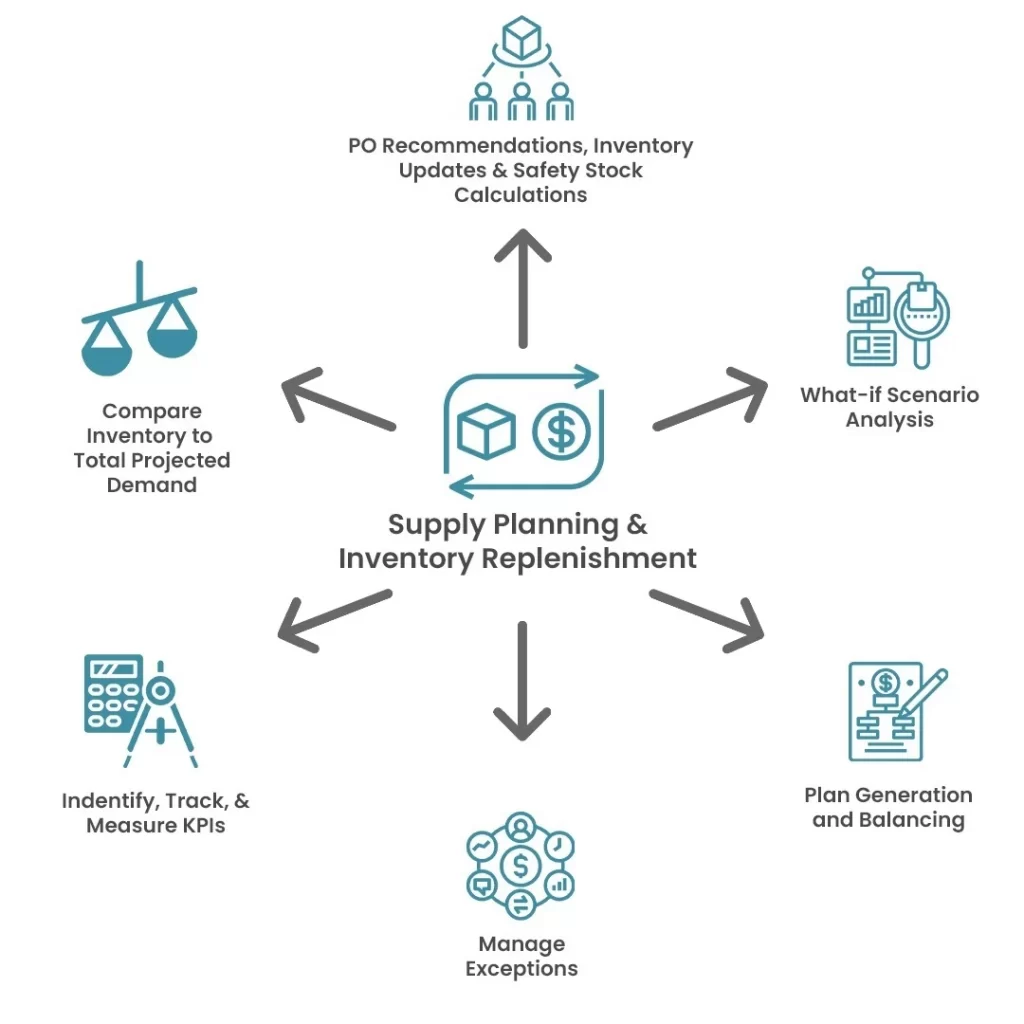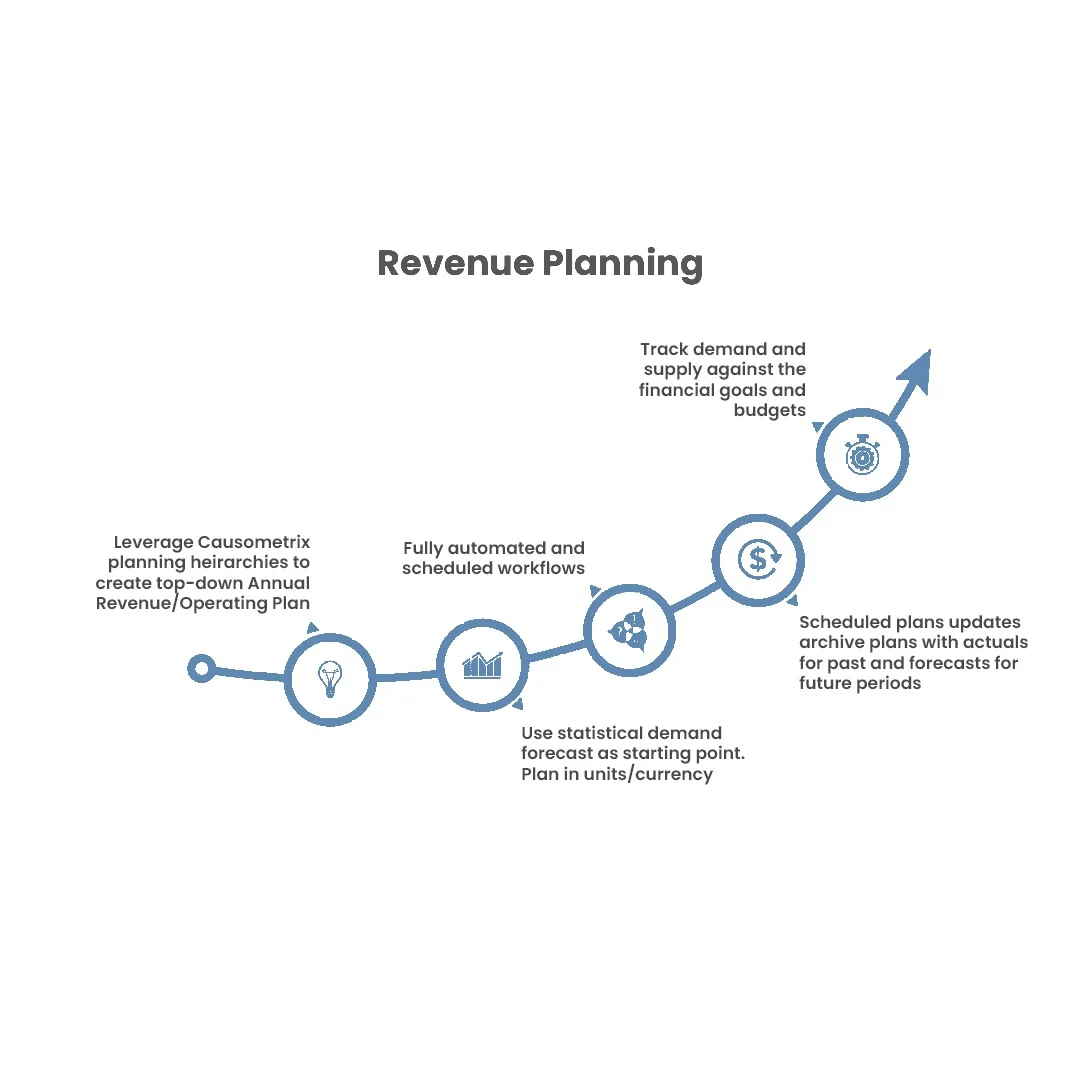Demand Management & Forecasting
- Management by Exception: You don’t need to manually forecast every product-location combination anymore. Tested and perfected out-of-the-box exceptions and custom exceptions configured for your specific business scenarios will help you identify and prioritize forecast exceptions by importance of the product.
- ABC Classification helps you segment your product-location combinations based on revenue, cost, volume, etc. Coupled with forecast exceptions, you can start your planning cycle focussing on forecast anomalies for your A products and moving down the list by ABC Classification.
- Demand Categorization helps you further categorize your product-location combinations as Smooth, Slow, Erratic, and Lumpy based on volatility in demand magnitude and inter-demand intervals. This gives planners an additional level of segmentation, helps us tune the statistical forecasting engine based on demand categories, allows users to have realistic forecast accuracy expectations from different demand categories, and helps your organization better understand the nature of overall demand for your products.


- Multiple constituents (sales, marketing, operations, etc.) collaborate and contribute to the demand plan in parallel using the Stat Forecast as their starting number. Arrive at a one-number Consensus Demand Plan using a weighted or selection based method.
- Conduct what if scenario analysis using the statistical engine simulation functionality. Compare multiple simulations and select the one that fits best.
- Our Statistical Forecasting Engine uses a blend of multiple statistical models, thereby mitigating the risk of over-fitting while improving forecast accuracy. In certain cases, the best fit approach may generate the highest accuracy when generating a fit forecast for past periods. But, it poses a risk of over fitting because the probability of the exact same pattern reoccurring in the future is extremely low.
- Time Series & Trend Analysis: Our engine analyzes historical data to identify trends in demand growth and decline. It then projects this into the future to forecast demand.
- Seasonality and cyclicality pose unique challenges to businesses. Causometrix tools provide insights into how to better plan for these fluctuations. Our engine applies advanced mathematical and statistical models to detect and measure the seasonality and cyclicality in your demand patterns.
- Automatic detection of Optimal Forecast Generation Levels: We do top-down or bottom-up forecasting based on what makes the most sense for the product/location combination being forecasted. Because some products sell frequently and some sell only a few times a year, our engine identifies the product and location levels that make most sense to generate a forecast based on past demand.


- Causal Factor Analysis: Causal factors are external influences that cause your demand to deviate from the norm. If you have identified external factors that are correlated to your product demand, our engine can incorporate them in the demand forecasting process. We have the expertise to research your business and/or industry, and conduct causal factor correlation analysis to identify the factors that are truly correlated to your demand. Causal factors, if chosen correctly, can be a huge help in better describing your demand history and therefore improving the quality of the forecast.
- Promotions / Events Planning: Flagging sales promotions and events in past periods helps better describe sales history to the statistical forecasting engine. The engine learns the impact of such factors and projects the lift/dip in the future.
- Get recommendations for when to place the next Purchase Order or Make Order based on different lead times
- Updated on-hand, in transit, frozen and other types of inventory balances and positions across all your warehouses on a nighly basis
- Get recommendations for when to place the next Purchase Order or Make Order based on different lead times
- Conduct what-if scenario analysis based on changes in demand and supply across your network. Publish changes to supply plan for individual items if needed.
- Generate a supply plan nightly based on latest demand and inventory picture while respecting Economic Order Quantities (EOQ), Minimum Order Quantities (MOQ), Min/Max Planning, and Container Loading
- Balance Inventory across warehouses with Distributed Planning. Define sourcing rules by product and warehouse.
Supply Planning & Inventory Replenishment

- Manage by exception – Excess, Overstock, Shortages, and Dead Inventory
- Measure and Track KPIs such as Inventory Turns, Days Inventory, Weeks On Hand, Weeks of Supply, Lost Sales, Utilization Rate, Demand Fill Risk, etc.
- Measure and Track Supply Chain Health using metrics such as Percentage On-time Delivery, Forecast Accuracy, Order Cycle Time, Production Plan Adherence, Capacity Plan vs Utilization, Sell-through Rate, GMROI, Out-of-Stock Rate, and Sales vs. Inventory Ratio
- Calculate beginning and ending inventory in week buckets based on demand and supply
- Compare beginning inventory to the total projected demand across the forecast horizon and identify instances where inventory cannot fulfill demand
- Capture Demand Forecasts from various constituents using dedicated workspaces. Provides visibility to inputs from all constituents and annual revenue plan.
- Compare and reconcile differences between forecasts from various constituents and the annual revenue plan with color coded alerts
- Conduct Demand Review meetings with exception reports and arrive at a one-number consensus demand forecast using weighted or forecast selection methods
- System generated Constrained Plan exceptions highlight gaps between demand forecast and fulfillment capacity
- Conduct demand and/or supply what-if scenario analysis to address and close gaps in demand and supply
Sales & Operations Planning

- Use the Constrained Plan to calculate actual Revenue, Profit, and Margins. Analyze exception reports that highlight gaps between actual revenue based on supply capacity and annual revenue plan.Use the Constrained Plan to calculate actual Revenue, Profit, and Margins. Analyze exception reports that highlight gaps between actual revenue based on supply capacity and annual revenue plan.
- Document the identified risks and opportunities in an S&OP scorecard
- Reconcile production, inventory, safety stock, and rough-cut capacity plans with the sales plan and financial goals
- Make sound and timely capacity, resource, CapEx, and inventory decisions
- Leverage Causometrix planning hierarchies and data allocation functionality to create top-down revenue / operating plans, and budgets. Adjust plans at granular item-location levels.
- Optionally, use statistical demand forecast as starting number for annual operating plan
- Plan in units and/or currencies
- Perform costing, pricing, revenue, and profit simulations and what-if-scenario analysis
Revenue Planning

- Automated workflows can be scheduled to capture snapshots periodically based on your business needs
- Scheduled workflow publishes the plans in units and dollars at the end of the current fiscal year for the upcoming year
- Continually track demand and supply against the financial goals and budgets to ensure that the organization is on track to achieve its financial goals
